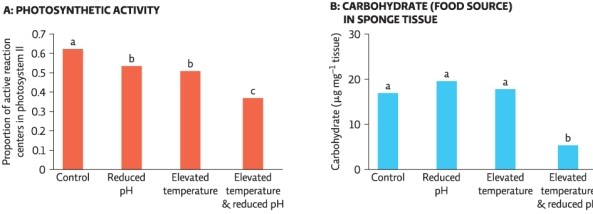Science Literacy Refer to the graphs below to answer the following questions. Below are data from a study (described in Module 6.3) conducted by Michael Lesser,Marc Slattery,and colleagues.The rate of photosynthesis (Graph A) and the amount of carbohydrate present (Graph B) ,an indication of photosynthetic production of sugars,were determined in sponges exposed to current temperature and pH (control) or to one of three test groups: the expected pH in 2100 (test group 1) ,the expected temperature in 2100 (test group 2) ,or both (test group 3) . (Note: Significant difference between groups is denoted by a different letter above the bars; if two groups share the same letter,they are not statistically different.) 
-What would the control conditions be for this experiment?
Definitions:
Economic Growth
An increase in the production of goods and services in an economy over a period of time, typically measured as the percent rate of increase in real gross domestic product (GDP).
Energy Resources
Natural resources that can be converted into energy to perform work, such as coal, oil, natural gas, sunlight, and wind.
Heat-To-Work Conversion
The process of converting thermal energy (heat) into mechanical work, such as in steam engines, combustion engines, and power plants.
Energy Quality
A measure of the ability of a type of energy to do useful work, accounting for factors such as efficiency and accessibility.
Q1: The term for trees that lose their
Q11: One important functions of a forest is
Q22: _ require(s)manufacturers to take back some of
Q24: _ affects diet by increasing the demand
Q26: Match each term in the left-hand column
Q36: List and describe several ethical issues involved
Q45: Refer to Infographic 5.You can find a
Q49: Refer to Infographic 3.Explain how the deeper
Q65: Discuss some ways that human alteration of
Q67: Robert Constanza and his colleagues estimated the